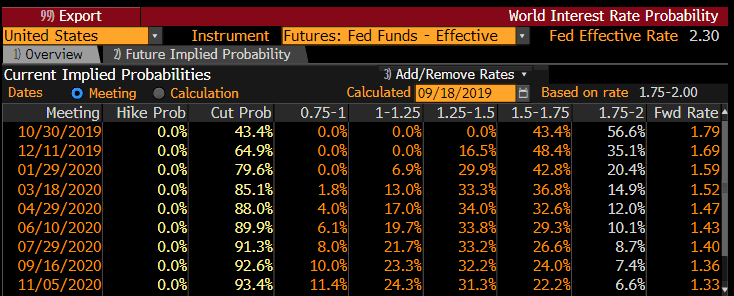
Interest Rate Outlook: Turmoil in Repo Market Overshadows FOMC Meeting
Today, the Federal Open Market Committee announced a 25 basis point cut in the overnight fed funds rate to a range from 1.75% to 2.00%, the second such action this year. In a normal week, building anticipation for the Fed’s policy decision and press conference would typically dominate the markets, but turmoil in the repo market has overshadowed the Fed meeting instead.
Disruption in the Repo Market
During the past two days, the overnight general collateral (GC) repo rate surged by over 6.00% to levels as high as 8.75%. The spike was uncharacteristic, as the repo rate is typically very stable and tends to trade in line with the fed funds rate. As background, the GC repo rate is the borrowing rate that dealers pay to investors who lend them cash (with treasuries and agency securities pledged as collateral). Dealers use this cash to help fund their daily transactions and trades, meanwhile the investors who ‘loaned’ the cash get an attractive rate of return, along with a pool of essentially risk-free assets as collateral. What we’ve seen so far this week included large impacts to both supply and demand. Primary dealers needed more cash than usual for their required purchases of a large quantity of new treasury issuance from the government. Less cash was available from investors who withdrew assets from money market funds to pay corporate taxes, and bank excess reserves were lower given contractions in the Fed’s balance sheet in recent quarters. As a result, the repo rate surged to dramatic highs and rates for very short-term commercial paper, treasury bills and agency discount notes also spiked, alongside the yields on money market funds that invest in these instruments. In response, the Federal Reserve intervened in the markets yesterday and today by opening a $75 billion daily facility to buy repurchase agreements from primary dealers.
FOMC Meeting
In its post-meeting statement, the FOMC cited “the implications of global developments for the economic outlook as well as muted inflation pressures” as motivation for its easing of monetary policy. Seven committee members voted for the action with Kansas Fed President Esther George and Boston Fed President Eric Rosengren dissenting in favor of no change and St. Louis Fed President James Bullard voting for a 50 basis point rate cut.
September Summary of Economic Projections
The Federal Reserve also released a fresh update to its Summary of Economic Projections. On the economic front, the median immediate, short-term and longer run projections for GDP, unemployment and headline and core PCE inflation were largely unchanged from the last release in June. In terms of monetary policy, seven of 17 officials are forecasting an additional 25 basis point rate decrease before year-end, but none of the 17 are currently expecting any further action beyond that cut, either in 2020 or looking forward as far as 2022.
Fed Funds Futures
The FOMC next convenes to discuss monetary policy on October 29th & 30th, but the markets are currently assuming that a final rate cut for the year wouldn’t occur until the Fed’s last meeting on December 10th & 11th. As of writing, fed funds futures are more pessimistic for the economy’s prospects than the Fed itself: they imply a 65% chance of a 25 basis point cut before year end and an 60% chance of a further 25 basis points in easing in the first half of 2020.

Source: Bloomberg
Our research is for personal, non-commercial use only. You may not copy, distribute or modify content contained on this Website without prior written authorization from Capital Advisors Group. By viewing this Website and/or downloading its content, you agree to the Terms of Use.
Please click here for disclosure information: Our research is for personal, non-commercial use only. You may not copy, distribute or modify content contained on this Website without prior written authorization from Capital Advisors Group. By viewing this Website and/or downloading its content, you agree to the Terms of Use & Privacy Policy.
